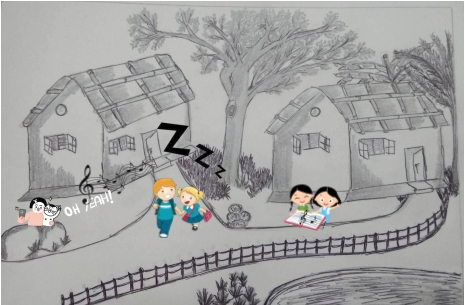Music soothes heart.
Rhythm provides practice.
To memorize your facts,
And steer your tracks.
Memory is
considered a gift in disguise. Though focus of education has shifted from knowledge
to skills. The significant of value of
remembering does not change. Appreciation
of all forms reach only to those who can recall and remember. New terminologies become ‘tongue twisters’
for youngsters in the early stages of learning.
Training them to pronounce and remember spelling is an uphill task for
the teacher to achieve. ‘Jingles’
provide scope for such training.
Understanding that earth is a combination of many spheres can be
diagrammatically and poetically represented as follows.
“EARTH – a sphere
Land in it, is lithosphere
Water on it, is hydrosphere
Air around it, is atmosphere
When we all live - its Biosphere”
Tapping
makes people happy
Music and
dance are form of expressions which gives emotional connection to
learning. It is well known fact that
engaging or interesting facts are not easily forgotten. Similarly, when emotions are associated with
learning, it is rarely erased. Institutions
come across many types of differentiation among its learners and teachers. The
mode of learning and the learning styles, though not always a constant shows
the variation among the learners. Among
teachers, the differentiation is the ability of some to take up the ‘dull’
subjects and change it to ‘entertaining visuals’ while some take up ‘most
disturbing’ segment of students to convert them to ‘most obedient’ mates. The key aspect behind such conversions are
‘strong emotional bonds’ created when learning happens both for the learner and
the teacher. When educationists can cater to this part of emotion, learning shows
a positive influence.
Many testimonials have shown that music enhance learning. Clarity of sound, words and rhythm develops with music. Jingles help develop such aesthetic sense among the students. A well-known jingle of conjunction is an example for this
Conjunctions:
Rhythmic
text goes long way in building a healthy brain.
Text when converted to such brilliant strokes it makes learning
memorable. ‘Schoolhouse Rock’s’ adverbs is another of such rhythmic development
of learning
Adverbs:
Mathematics
has some of the most confusing terminologies.
Reinforcement and repeating of the concept helps build a concrete
understanding of the most basic facts.
Fractions here shows the way.
Fractions:
Creating
such jingles can also be promoted in a classroom. It can be done by the teacher or by an interested
student for the benefit of others. Such
work when appreciated provides scope for developing such skills further. Most often, concepts are presented from
different perspectives. Journey of a river, is presented as interesting
experiences by many writers and poets, from the language perspective, example ‘River of Life’ by
Thomas Campbell compares the flow of river with the stages of life. This is literature perspective, however, when
the concentration is towards developing terminologies the same concept of river
can be changed with some amount of literary aspects.
Journey of a
River – Geographical terminology perspective.
“River, river! You are clever
Straight from a source,
Moving down the slopes,
Waterfalls and streams,
Making your way green,
Down in the plains,
Meandering the fields,
Tribute and distribute,
Along the state,
Alluvial to the delta,
Settling at mouth
agate.”
The
philosophy of learning has taken a shift in its approach towards ‘lifelong
learning’. To acquire immense knowledge and
develop capacity to learn is to be tuned towards individual abilities and
capabilities. Conceptual understanding
is hyped in classroom when process and procedures are set as routines. Plain sentences seldom draw the students
towards learning. Knowing pretty well,
the attention span among learners is not always a constant, it becomes
difficult to achieve the goal of learning the concept.
New ways
have always interested educationist, however, old ways of singing while
teaching has reached a stage of fossilization. Jingles and Rhymes still steal the hearts of
children, proof of such an ability can be seen when some of the advertisement jingles
are famous than the product themselves. Good Jingles go a long way in memory
retention. However, rocking music for
lessons is still a distant dream.
Developing good jingles can be a way to achieve a ‘learning
generation’.











